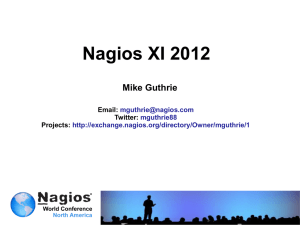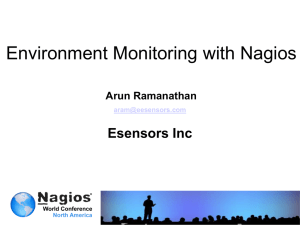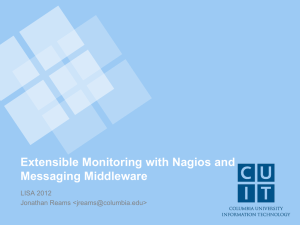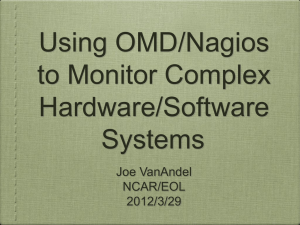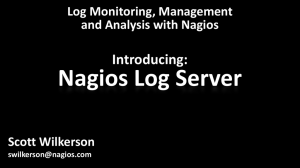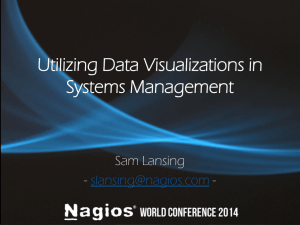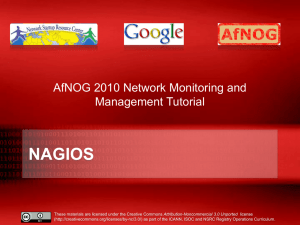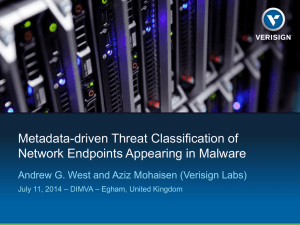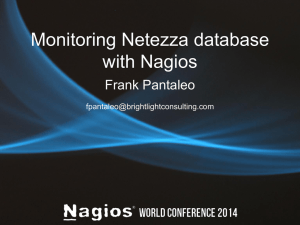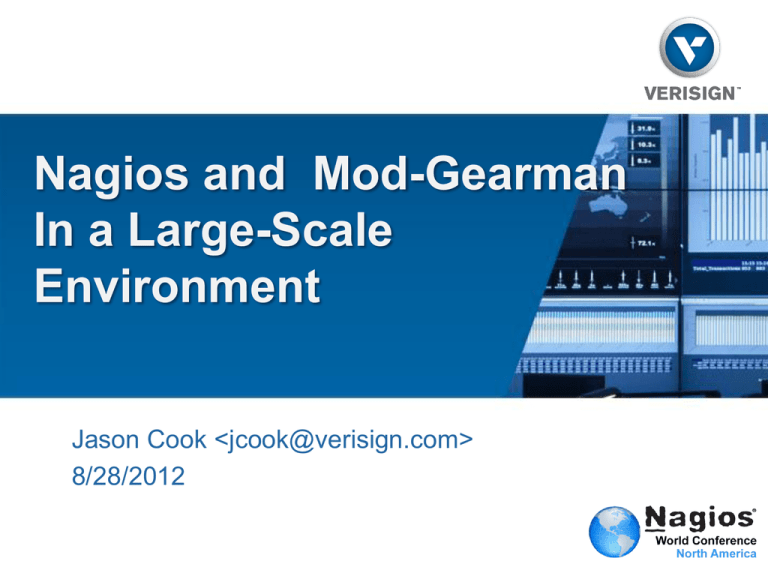
Nagios and Mod-Gearman
In a Large-Scale
Environment
Jason Cook <jcook@verisign.com>
8/28/2012
A Brief History of Nagios
at Verisign
Verisign Public
2
Legacy Nagios Setup
• Whitepaper NSCA configuration
• Typical 3-Tier setup
• Remote System
• Distributed Nagios Servers
• Central Nagios Servers
• Architecture in-place for several years
• Reasonably stable, though high-maintenance
• Very heterogeneous environment.
• Many OS and Nagios versions
• All notifications sent to an Event Management System
• Offloaded graphing/trending to a custom solution.
Verisign Public
3
Simplified Passive Architecture Diagram
Verisign Public
4
Challenges with our passive setup
• Scaling the Nagios server layers
• Requires changes to all NSCA instances using the servers
• Load-Balancing solutions mostly require removing freshness
checks…
• Freshness checking is a challenge
• More freshness checking means more Nagios forking.
• More Nagios forking is more operational sadness in a large
environment.
• With Freshness, you end up having an active environment, even
if it wasn’t your intention.
• Freshness errors do not tell the whole story
• Where is the problem?
• Even if you know where the problem is, it can be difficult to track
down what’s causing it. Nagios? Plugin? System busy? NSCA?
Network? Many questions, few obvious answers.
Verisign Public
5
Challenges with our passive setup (continued)
• Lack of centralized scheduling
• Adjusting schedules can be difficult for those without in-depth
knowledge of Nagios and how it all works.
• Inability to have a user run a check immediately without
having even more in-depth knowledge about Nagios.
• Lots of Nagios builds for various platforms.
• Since we were using NSCA, we needed libmcrypt for
encryption.
• libmcrypt not a standard library for many systems, so yet another
package to maintain.
• All of this needed quite a bit of custom code for
intelligent result queuing/sending so as to gracefully
handle network outages and minimize send_nsca
forking (especially on the distributed servers).
Verisign Public
6
A Move to Active
Monitoring
Verisign Public
7
An alternative arises…
• Gearman
• Provides a generic application framework to farm out work to
other machines or processes that are better suited to do the
work.
• Integrates with Nagios via the Mod-Gearman NEB module.
• NRPE
• Nagios Remote Plugin Executor
• Merlin
• Module for Effortless Redundancy and Loadbalancing In
Nagios
• Allows our Nagios instances to share scheduling (and
therefore check results) between one another.
• Great for load sharing and redundancy
Verisign Public
8
Simplified Active Architecture Diagram
Verisign Public
9
Some details about the setup
•
•
•
•
•
All components run in VMs
Nagios 3.4.1 (with nanosleep)
Merlin (1.1.15)
Mod-Gearman 1.2.6
MK Livestatus (perhaps the greatest NEB module of all
time)
• Merlin setup is a simple peer<->peer configuration
• Mod-Gearman NEB modules are configured to talk to
multiple gearman servers (gearman server preference
is alternated on each system, so that Gearman server
failures are easily handled)
• One Mod-Gearman worker process for each gearman
server per worker.
Verisign Public
10
VM Configuration & Performance
• VM Configuration:
• 4 V-CPUs
• 2GB RAM
• Linux 2.6.32
• Performance Considerations
• Very CPU Bound
• RAM usage is very low
• VM Usage
• 2 Nagios server
• 2 Gearman Server
• 2 Mod-Gearman Workers
Verisign Public
11
Application Configurations
• Nagios
•
•
•
•
•
•
100000 services @ 5 minute interval
sleep_time = 0.01
host_inter_check_delay_method=n
service_inter_check_delay_method=0.01
max_concurrent_checks=0
5 gearman collector threads
• Gearman
• 10 I/O Threads
• Mod-Gearman Workers
• 1000 worker processes per system
• 50 per second max spawn rate
Verisign Public
12
Performance Results
Verisign Public
13
Observations
• These 6 VMs can easily handle 20000 active services
per minute.
• Additional capacity can be had easily
• Add Merlin peers
• Add more workers
• Scales up very well
• renice of critical processes makes sure they’re getting
the priority they need.
• The environment can be a bit fragile.
• Less fragile than before, but still has several components
which all must be working correctly.
Verisign Public
14
Benefits
• Much less hardware
• Centralized view and control over all monitoring
• Opportunity to leverage the Gearman architecture for
other services
• Higher confidence in monitoring accuracy
• More flexibility in scheduling logic.
• Event handlers become very useful, since there is a
broader view of the infrastructure via MK Livestatus.
Verisign Public
15
Final Thoughts
• Tested several methodologies before arriving at the
Nagios+Gearman conclusion.
• Multisite
• DNX
• NRDP
• The current design is still a work in progress, but will
be easier to change and grow (Nagios 4?).
• Move anything possible off of Nagios and to external
processes.
Verisign Public
16
Credits
• Verisign System Administrators for helping me test
• Gearman (http://www.gearman.org)
• ConSol Labs (http://labs.consol.de)
• Thruk
• Mod-Gearman
• Mathias Kettner (http://mathias-kettner.de)
• MK Livestatus
• op5 (http://www.op5.org)
• Merlin
• Nagios (http://nagios.org)
• Nagios Core
• NRPE
Verisign Public
17
Thank You
© 2012 VeriSign, Inc. All rights reserved. VERISIGN and other trademarks, service marks, and
designs are registered or unregistered trademarks of VeriSign, Inc. and its subsidiaries in the United
States and in foreign countries. All other trademarks are property of their respective owners.

